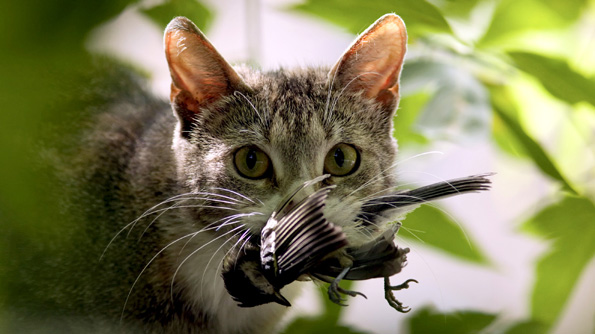 |
| one billion birds each year. |
|
|
|
|
|
GUEST VIEW
Lori Ogozalek
West Alexander, PA.
I would like to comment on your story on feral cats in North Tonawanda.
The problem of feral cat overpopulation cannot be solved with trap, neuter, and release (TNR) programs.
TNR programs perpetuate the irresponsible human behavior of dumping and abandonment that caused the problem in the first place. Municipalities that embrace TNR are encouraging more dumping and abandonment.
With approximately 80 million free ranging cats across the US, no one will ever be able to sterilize enough of them to have any significant impact on cat populations.
The claims TNR advocates make that sterilization will reduce/control/eliminate feral populations is fiction, dragged out to convince city officials to pass TNR programs.
There are many peer reviewed scientific studies that show TNR programs DO NOT have a significant impact on citywide populations of feral and stray cats, and NONE that show they do.
TNR is a feral cat maintenance program, not a feral cat reduction program, and can cause cat populations to grow. Two examples of that are: Phoenix University in Arizona stopped its eight year TNR program, citing: "Instead of stabilizing the population, the population doubled, creating an unhealthy situation for the cats and our community."
In south Miami, cat populations have exploded since the onset of TNR.
Additionally, municipalities who embrace TNR as “humane” are not considering the inhumane cost to wildlife and the people who love them.
Not only does TNR not solve the population problem, it restricts property rights, threatens human health, destroys wildlife, and is cruel to cats.
Who will be liable for cats that destroy private property? The property owner or resident, not the city or TNR participants. Feral and stray cats expose children to Toxoplasmosis - found only in cat feces - rabies, and other zoonotic diseases when they deposit packages of feces and stinking urine in yards, sandboxes, parks, around schools, near restaurants, and shopping centers.
Who will pay the medical bills and endure the health consequences of Toxoplasmosis? The victims, NOT cat feeders, TNR supporters, or city agencies.
There are 10,000 to 13,000 people bitten by rabid cats annually, as determined by the Center for Disease Control. No resident or property owner should be forced to accept on their property the invasion of a feral or stray animal that is being fed and maintained by someone else.
The practice of TNR causes the slaughter and wasting of our valuable and loved birds and other wildlife. Thirty-three species of birds have been driven to extinction worldwide, linked to free ranging cats. Several species of shorebirds in the US are on the brink of extinction, linked to free ranging cats. So much cat feces is seeping into the oceans from rivers, marshlands, and beaches that the corpses of sea mammals such as Manatees, Beluga whales, seals, and dolphins are washing ashore, their deaths caused by Toxoplasmosis, found only in cat feces.
No cat will take the place of insect eating birds and mammals that cats are pushing into extinction. Even a well fed cat kills and maims. If the science demonstrating the decimation of wildlife by cats isn’t enough proof, talking with a wildlife rehabilitator will give you some personal insight into how many native birds and mammals are slaughtered and maimed by free ranging cats.
Should compassion only extend to cat lovers? How many birds and wild baby mammals is one cat worth?
A more sound system is TENVAC (trap-evaluate-neuter-vaccinate-adopt-contain), a professional, public/private partnership cat sanctuary method that protects human health, wildlife, property rights, and the cats. TENVAC acknowledges, respects, and addresses the concerns of all stakeholders. Everyone is treated equally and everyone gets an equal share of the pie. Cats are domestic animals that need responsible owners, not a system that encourages the dumping of a lethal domestic predator. Consider this: the free ranging feral dog problem was whipped by containment, not more laxity.
|

